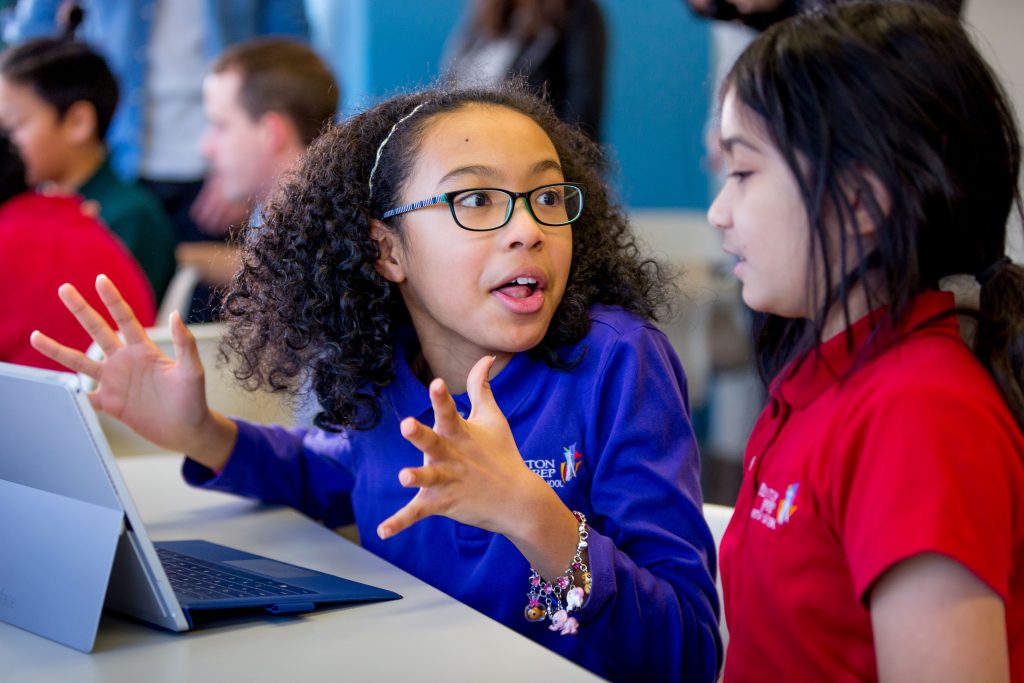
From ‘Minecraft’ to mixed reality, Microsoft is preparing students for the future
One sunny morning in December, sixth-grader Sophia Sta. Rosa and a classmate were busy working on a book report project, using “Minecraft: Education Edition” to build an amusement park with rides based on events in a novel.
The girls created a rollercoaster, a water slide and other attractions for their park, setting their own criteria and rules for the project. They didn’t want it to be too easy, Sta. Rosa explained, and they wanted to show responsibility so their teacher would let them tackle more complex challenges. To the 11-year-old, the most important lessons she was learning from “Minecraft” weren’t about building structures or coding, but collaboration and problem-solving.
“It’s a really big project and we have a deadline. If we want to get the whole thing done, we have to work together and help each other out,” Sta. Rosa said. “Collaboration is important later in life.”
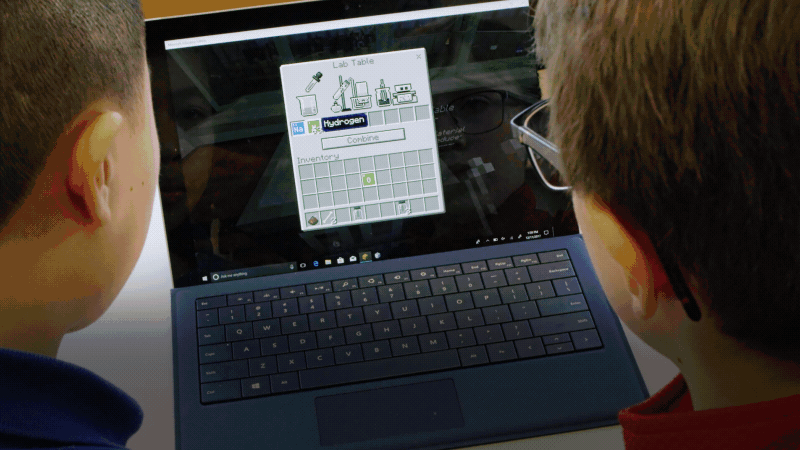
The sixth-grader’s comments reflect findings in new Microsoft research, “The Class of 2030 and Life-Ready Learning.” The research looked at the skills today’s kindergartners will need, how teachers can best prepare them through their educational journey and the role that technology will play. Conducted in collaboration with McKinsey & Company’s education practice, the research involved surveying 2,000 students and 2,000 teachers across the U.S., the U.K., Canada and Singapore, reviewing 150 pieces of existing research and interviewing 70 thought leaders.
Sta. Rosa, like the graduating class of 2030, will leave school needing to be ready for jobs that have not yet been created, for technologies that have not been imagined and for the opportunity to solve social and global challenges that have not yet been anticipated.
The research highlighted several themes, including a new focus on social skills and emotional competencies and an ongoing need for personalized learning. It identified the shifts required to move from current educational models to student-centric approaches. The research also reinforced a continued focus on cognitive skills and identified variances between teacher and student priorities around technology, the importance of creativity and feedback on social and emotional skills.
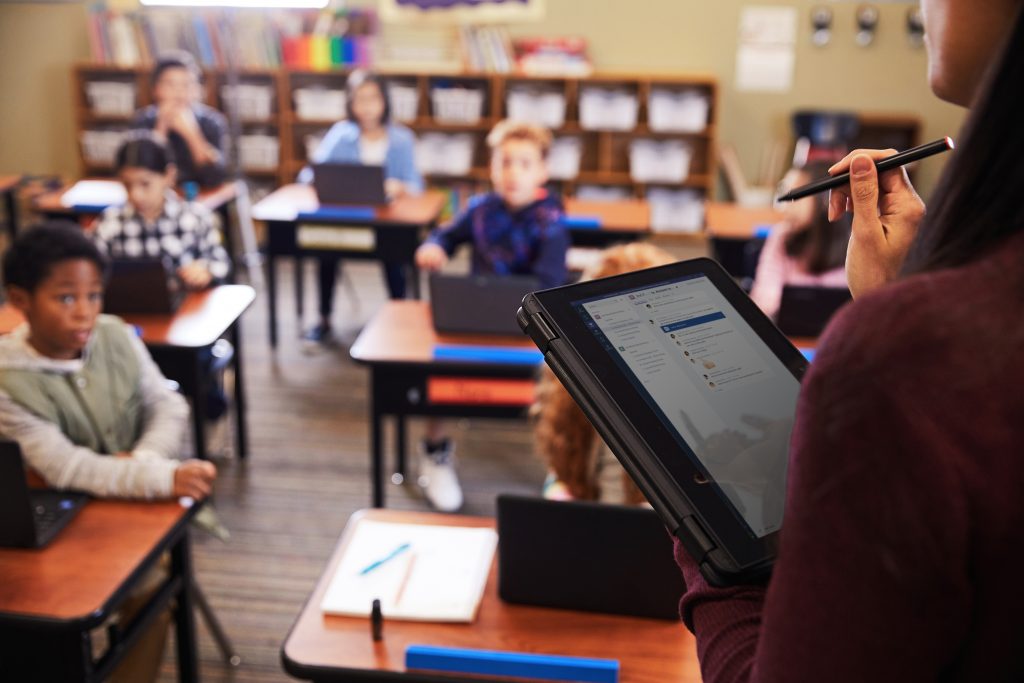
Social and emotional competencies were considered important by all groups surveyed. The existing research showed that those competencies help build cognitive skills valued in classrooms and the workplace, such as complex problem-solving, creativity and critical thinking. Those skills will be essential to prepare students for growth in employment as automation replaces routine and repetitive tasks, the research found.
The research also identified some challenges. Just 42 percent of employers felt new hires were adequately prepared for the current workforce, identifying a gap around social and emotional skills. That shortfall is expected to increase, since 30 to 40 percent of jobs that will grow by 2030 are expected to require those skills.
And today’s students, like Sta. Rosa, aren’t content to be passive recipients of education, the research found. They want to solve problems, be creative and have choice and influence over their education. They want learning to be purposeful and personal, and view technology as a way of making sense of, and contributing to, their world.
“The research highlights the importance of social and emotional skills in young people’s learning and in their future lives,” said Barbara Holzapfel, Microsoft general manager for Education Marketing. “Teachers are uniquely skilled to help students develop social and emotional skills.”
That human connection will require more teachers. Teaching is one of the occupations likely to have the largest job growth by 2030 — between 3 and 9 percent, according to the research — and is identified as one of the roles least at risk of automation.
“Technology can play an important role in facilitating and supporting learning, which requires a true human-to-human connection,” Holzapfel said.
Driving personalized learning through technology is the focus of a project Microsoft is supporting in Douglas County School District in Colorado. Teachers at the three schools participating in the project — Cherokee Trail and Heritage elementary schools and Mesa Middle School — first collected data on each student, then developed goals in collaboration with students and created personalized plans for them in OneNote, Microsoft’s digital notebook app. The plans include recommended resources and apps students can use to meet their goals. Students monitor their own progress, choosing the tools that best meet their needs.
“It’s giving them total autonomy,” said Mary Murphy, innovation and personalized learning specialist for the three schools. “It’s up to the student to choose the learning pathway that works for them.
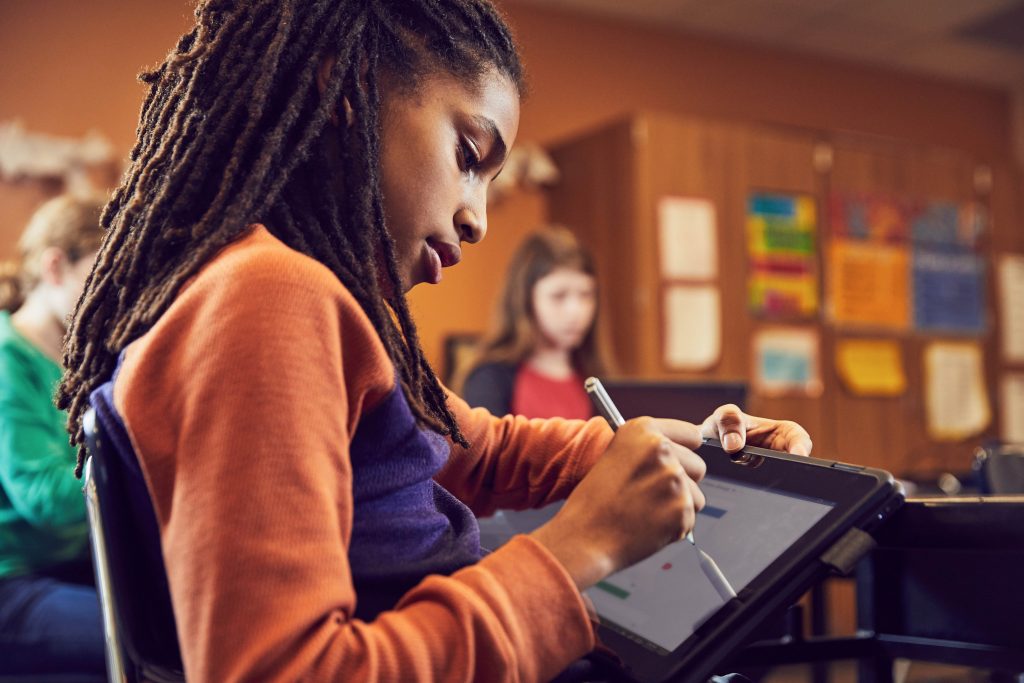
The approach is being used in various subjects at the three schools and has transformed their approach to teaching, Murphy said. While in class, students work in a shared OneNote Class Notebook, using digital pens to solve problems and jot down thoughts. They can see in real time how their classmates are working through exercises and decide if they want to collaborate, work on their own or ask the teacher for help. Teachers also have access to the notebook and can monitor students’ work and step in as needed.
Writing with digital pens, rather than typing on a keyboard, helps students process learning in a way that simply listening to a teacher stand at the board and lecture doesn’t, Murphy said.
“We are not eliminating the teacher through this process,” Murphy said. “We’re only strengthening the learning process through technology.”
The three schools are also working on a “global classroom” project with schools in Ireland, Australia, Spain and Canada. The students are collaborating to identify a universal problem or challenge in their respective communities and come up with solutions. Meetings are held via Skype, and OneNote and Sway, a Microsoft presentation program, are used to share information with the other schools. The initiative is fostering the skills highlighted in the new research — empathy, collaboration, problem-solving — and giving students valuable cross-cultural experience, Murphy said.
“Our students are getting an opportunity to connect with their peers in another country, and to collaborate and look at the world through a global lens,” she said.
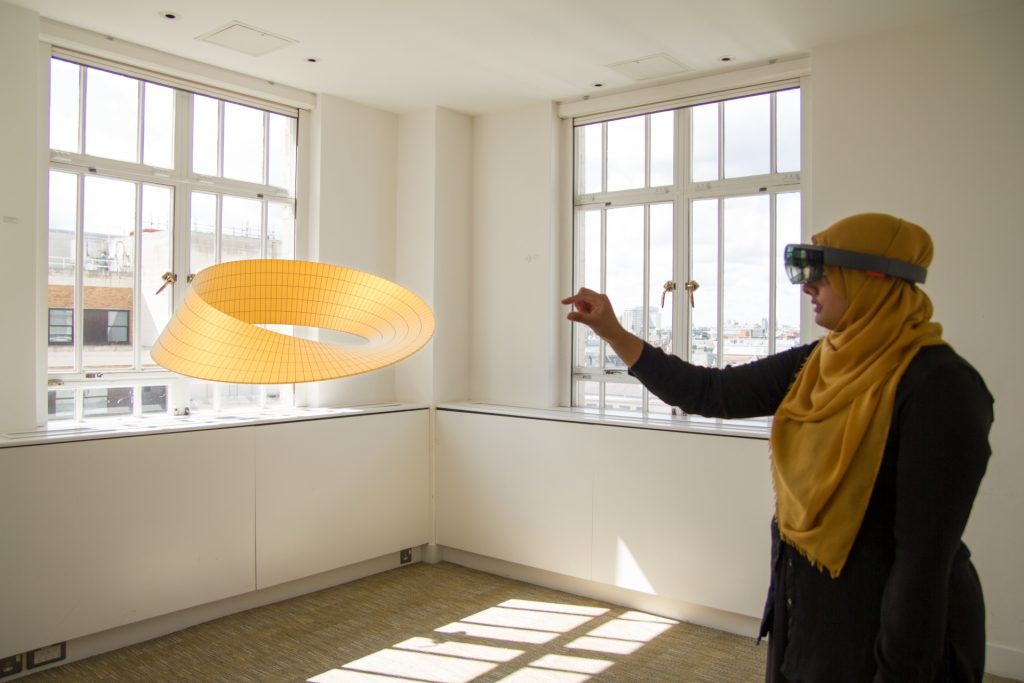
Supporting student achievement
Microsoft has a long-held commitment to empower every student to create the world of tomorrow and provide classroom tools that live up to the same high standards teachers set for their students. With its partners, the company has introduced a range of affordable devices that give students access to cutting-edge capabilities such as inking, touch and 3D that align with how young people learn. Accessibility features like dictation and text decoding features are helping students of all abilities improve reading, writing and comprehension.
New approaches to learning, from mixed-reality applications to hands-on lesson plans, are providing students with rich, immersive experiences to spark their curiosity and creativity. For example, curricula and apps such as “Minecraft: Education Edition” are designed to ignite a passion for science, technology, engineering and math, or STEM subjects, and teach future-ready skills like coding in natural and engaging ways.
That goal of bringing lessons to life and providing hands-on STEM activities led Karon Weber to launch Microsoft’s Education Workshop almost two years ago. The workshop’s Hacking STEM initiative provides low-cost, interactive STEM lesson plans for middle school students. The lessons enable students to solve real-world problems and be creative — priorities identified in the new research by both students and teachers as critical skills for the future.
There are seven lesson plans so far, including an exercise that uses Legos to measure angles and map out an island with a mountain, then bring it to life with Microsoft’s 3D Paint app. All lessons are available at no cost online and include instructions, a digital notebook for students and teachers, and shopping lists.
“Our goal is to try and figure out how to make STEM accessible to everyone,” said Weber, Microsoft’s partner director for the Education Workshop. “Everything we do, we do from a learning perspective to try and help us gain new insights into how we can empower teachers to eventually start to do this themselves.”

Powerful tools for immersive learning
Microsoft’s research suggests that mixed reality — the combination of augmented and virtual reality — helps students learn because it activates multiple areas of the brain while also giving them independence and opportunities to explore worlds beyond the physical limits of the classroom. Microsoft’s Mixed Reality team has been working to develop applications that teachers can use to give students experiences that allow them to interact with information in new ways.
“Mixed reality is such an effective way to facilitate creative, immersive learning,” Holzapfel said. “It engages students in rich, meaningful experiences that help them see and understand their world. It gives them the ability to direct their own learning, something students we surveyed identified as a high priority.”
To better meet the demand for mixed reality in the classroom, Microsoft is expanding on the success of HoloLens, the world’s first self-contained holographic computer, with the recent launch of lower-cost virtual-reality devices and curricula for K-12 schools. In March, the company will roll out six new augmented reality and virtual reality applications developed in partnership with curriculum provider Pearson that focus on subjects including chemistry, math and history.
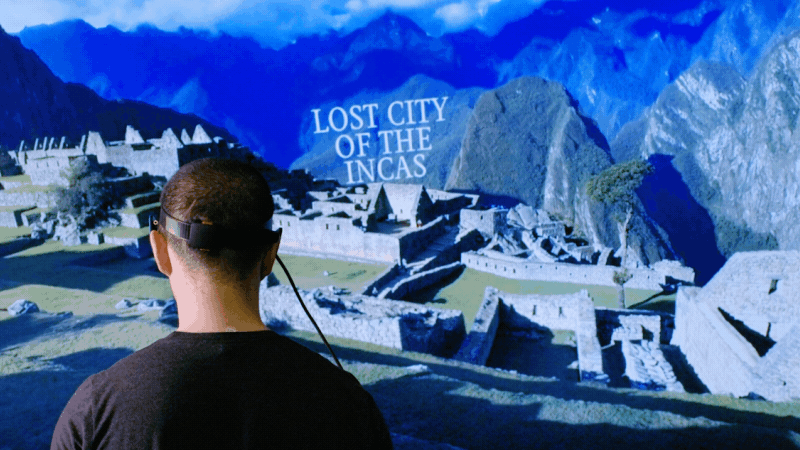
Research has shown that 3D technology can also improve learning and retention among students, since visualization helps make complex topics more understandable.
“Imagine, rather than sitting through a half-hour lecture, you sit through a 10-minute lecture and then we put you into an experience to reinforce everything your teacher has just told you. That retention is going to be so much higher,” said Dan Ayoub, Microsoft general manager, Education.
“We can really give students something they’ve never had at any other point in our history before to do anything and learn without fear of failure,” Ayoub said. “We can put them in a chemistry lab and if they blow it up, it doesn’t really matter. When you remove that fear of failure, you have an incredible tool for the future.”
Technology that engages the senses
Technology has been part of the education landscape for decades, but has traditionally been used to automate processes or digitize content. Now, it is increasingly enabling learning in ways that blend the physical and digital universes, reflecting how students today interact with the world. Touch screens were an early example of that shift and 3D learning is another, said Lorraine Bardeen, general manager for Microsoft HoloLens and Windows Experiences.
“All humans are 3D experts. But we’ve been taught to visualize technology on a 2D computer screen,” she said. “All we’re doing now is getting computing closer and closer to what’s natural for human ability. It’s pushing computers to act like humans act and interact more like we interact in the real world.”
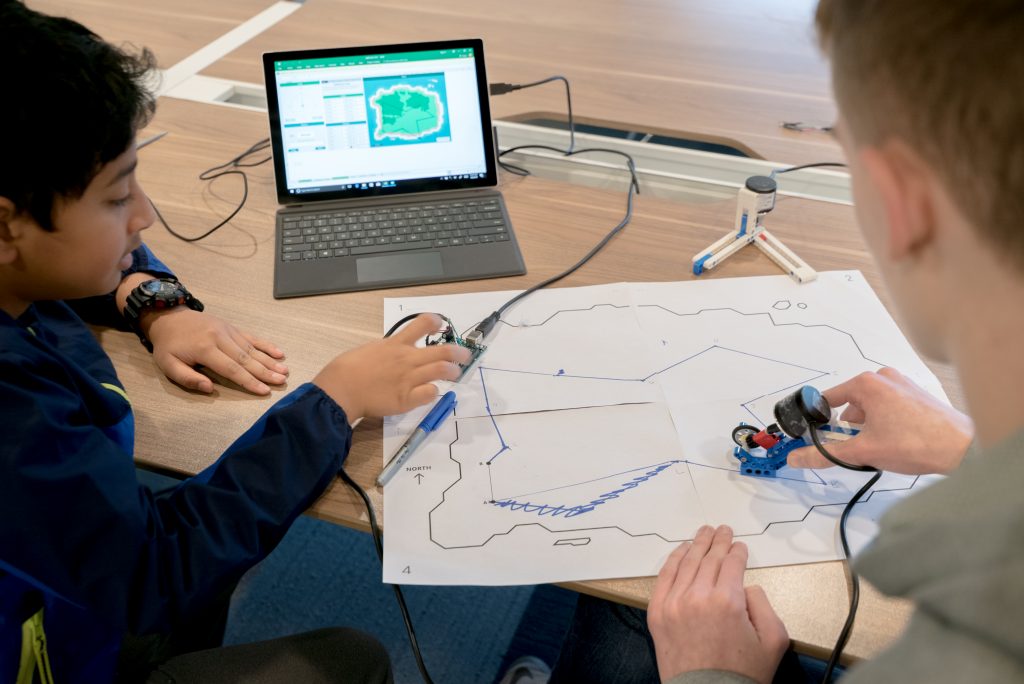
Similarly, digital pens and inking are being used in classrooms not just to restore the lost art of penmanship, but help students retain what they’re learning. Microsoft has built digital inking capabilities into various educational devices and apps, and the technology is being used in classrooms by both teachers and students.
Cheryl McClure, a science teacher at the International School in Bellevue, Washington, has her students take notes, draw ideas and answer questions with digital pens. Since incorporating the pens, she’s noticed an uptick in students retaining information.
“You can listen to somebody and type verbatim and not really think about what they’re saying, but if you write it down, you have to process it,” she said. “I see it with my students that when they write things down, they remember them.”
Microsoft’s recent education efforts have also focused heavily on supporting classroom collaboration. McClure and Jess Pilsner, a teacher at Renton Prep, both use Microsoft Teams for their classes and say the chat-based tool helps students work together on and off campus. One of McClure’s classes used Teams to collaborate on a science project about Mars, sharing links and other resources. Pilsner said Teams saves her time and gives students ownership of their education.
“They absolutely love it for communicating,” Pilsner said. “They’re in charge of posting their own homework, so they’ll ask questions and respond to each other. That’s great as a teacher, because the questions I end up answering a million times, they’ll answer themselves.”
Pilsner sees another benefit of Teams in helping students learn to navigate digital communications, from using appropriate wording to being aware of different personalities and communication styles.
“Is it always used properly? Of course not,” she said. “These are 10-, 11-, 12-year-olds learning to use a collaboration tool that adults use. But they get to have those conversations now, so that later, they already have those skills. It’s better to learn that in a classroom than in your first year on a job.”

McClure was an early adopter of OneNote Class Notebook, Microsoft’s most robust classroom collaboration tool. The app provides the ability to create private student notebooks where teachers can provide feedback and grade assignments, content libraries where teachers can distribute course materials and homework, and a shared collaboration space for teachers and students. Images, audio, video and inking can be used in Notebook, making it a rich digital canvas.
Mike Tholfsen, principal product manager for Microsoft Education, helped create Class Notebook after talking with teachers around the country about what they need. Tholfsen said the application has become a powerful tool for various types of collaboration — teachers can observe students working and provide real-time feedback privately to a student, for example. Or an educator working with a special needs student, who would typically sit beside the student, can interact from elsewhere in the classroom or even another room so the student doesn’t feel singled out.
“It’s a completely destigmatizing, collaborative scenario,” Tholfsen said. “There’s story after story like that. People are using the tool to do things they couldn’t do in an analog world.”
Microsoft’s Immersive Reader tool was designed to help students with dyslexia and dysgraphia. Available in 30 languages and used in schools around the world, the tool can read text out loud, break words into syllables, highlight words or lines of text, change text size and spacing, and alter background color.
Available in Microsoft products including Word, OneNote and Outlook, the application is helping students across the learning spectrum — a recent study found that fourth-graders in the Bellevue School District who used Immersive Reader had significantly higher gains in reading comprehension than those who didn’t.
A new paradigm
The class of 2030 will graduate into a fast-changing world requiring a range of social and emotional skills to thrive in both work and personal life. Over the next 12 years, the Microsoft research found, as many as 375 million people worldwide may need to learn new social and emotional competencies to meet the demands of the workplace.
The research points to a pivotal time in education, with learning shifting from a top-down, school-centric approach to a student-centric one. Teachers and schools face intriguing new challenges to help students develop the skills and dispositions required to navigate an increasingly complex, technology-driven society. Getting there requires students to be active participants in their education, with teachers helping to guide them and leveraging technologies that help build skills such as critical thinking, collaboration and problem-solving.
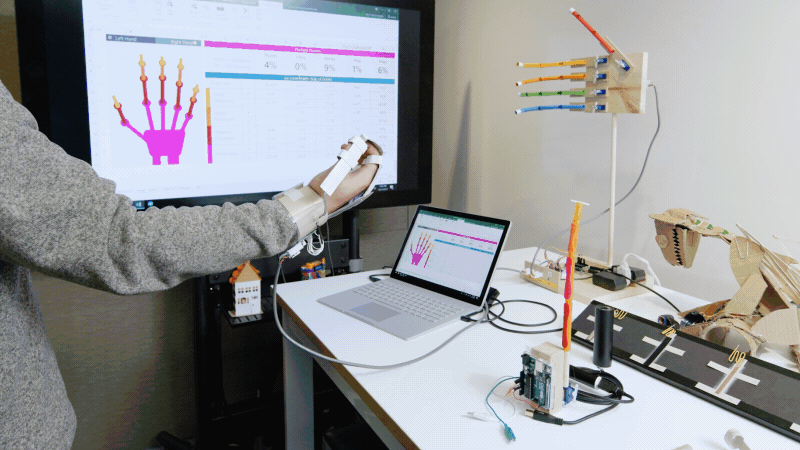
Anthony Salcito, Microsoft vice president for Worldwide Education, said technology has fundamentally changed how today’s students see themselves and learn about their world. The challenge for educational systems will be to leverage technology in a way that supports that shift, he said.
“What’s happening in schools has been reflective of technology being part of the change, but the core shift is fundamentally about people,” Salcito said. “It’s about how do you shift the thinking in the way teachers embrace this new world of learning? How do you motivate students to participate in their world and inspire them to make a difference? Those are the shifts that schools are involved in.”
Going forward, Salcito sees a role for Microsoft in helping schools and educational systems use data to provide predictive insights that can improve student outcomes — whether that means developing personalized learning plans or identifying students at risk. Artificial intelligence, analytics and the cloud will be key to those efforts, he said.
“If you look at where schools are going, a big part of the journey is data,” he said. “Every school is on a data journey, whether they articulate it as a personalized learning journey or they want to drive better learning outcomes.”
Ultimately, Holzapfel said, the challenge will be to harness technology to enable students to develop the skills they need.
“Technology can play an important role in preparing students to be happy, productive, successful adults,” she said. “Our research clearly demonstrated that young people have high expectations for their education and a clear sense of the skills they will need to succeed at work and in their personal lives.
“Our goal at Microsoft is to provide the applications and solutions that put students front and center, and that empower every learner on the planet to achieve more.”
Lead photo: Students at Renton Prep Christian Academy discuss a project they’re working on using “Minecraft: Education Edition.” Photo by: Scott Eklund



















